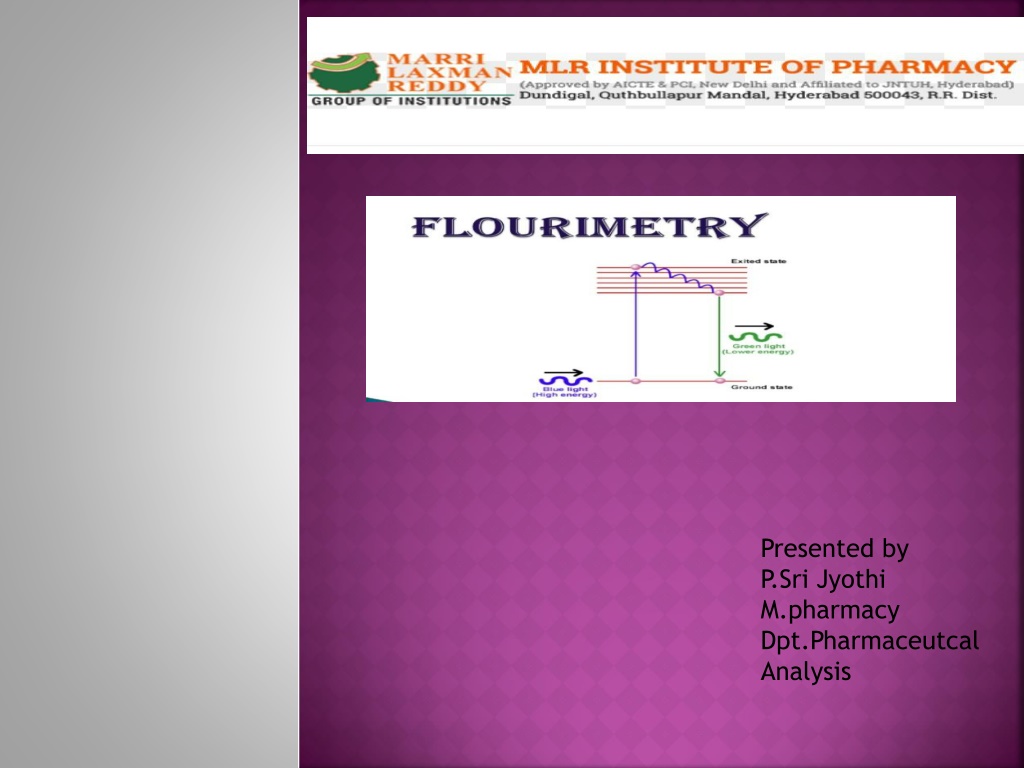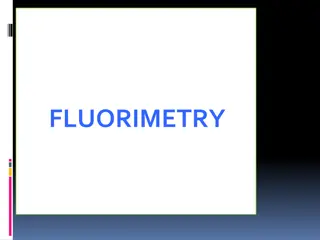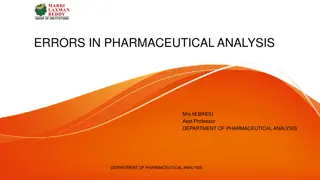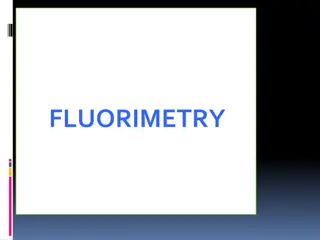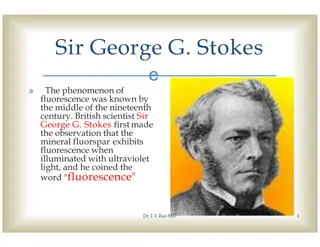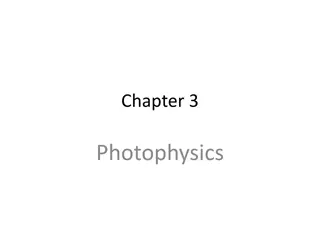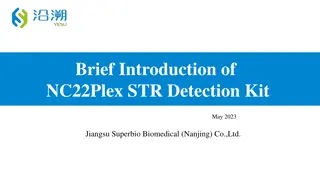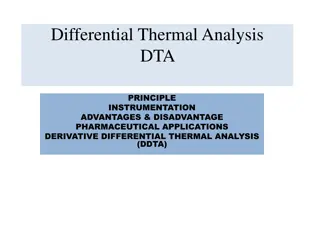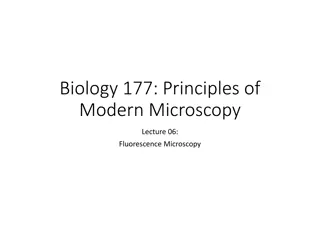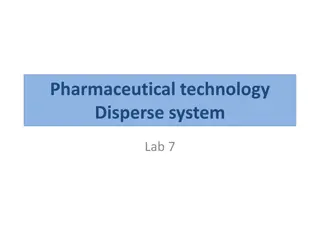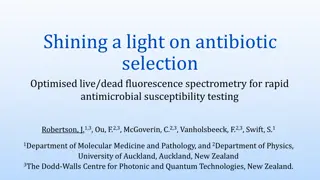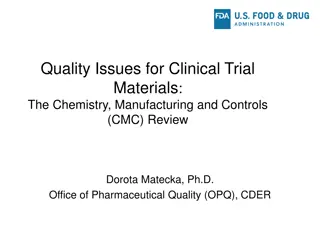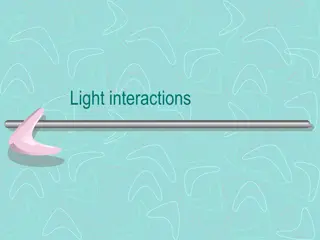Understanding Fluorescence Analysis in Pharmaceutical Sciences
Fluorescence analysis is a crucial technique in pharmaceutical analysis, involving the emission of radiation by molecules when excited at specific wavelengths. Factors influencing fluorescence, such as concentration, light intensity, adsorption, oxygen presence, pH, temperature, viscosity, and photodecomposition, impact the accuracy of measurements. Fluorimetry aids in quantifying fluorescence intensity, while maintaining optimal conditions for accurate results is essential for reliable analysis in pharmaceutical applications.
- Fluorescence Analysis
- Pharmaceutical Sciences
- Fluorimetry
- Factors Affecting Fluorescence
- Medicinal Chemistry
Download Presentation

Please find below an Image/Link to download the presentation.
The content on the website is provided AS IS for your information and personal use only. It may not be sold, licensed, or shared on other websites without obtaining consent from the author. Download presentation by click this link. If you encounter any issues during the download, it is possible that the publisher has removed the file from their server.
E N D
Presentation Transcript
Presented by P.Sri Jyothi M.pharmacy Dpt.Pharmaceutcal Analysis
CONTENTS PRINCIPLE PRINCIPLE FACTORS EFFECTING FACTORS EFFECTING FLOURESCENCE FLOURESCENCE INSTRUMENTATION INSTRUMENTATION APPLICATIONS APPLICATIONS CONCLUSION CONCLUSION REFERENCE REFERENCE 2 Dept of Analysis
FLOURESCENCE: It is a phenomenon of emission of radiation when the molecules are excited by radiation at a certain wavelength. Dept of Analysis
FLUORIMETRY: It is a measurement of a fluorescence intensity at a particular wavelength with the help of filter flourimetry or spectrofluorimetry. Dept of Analysis
Factors effecting fluorescence: Concentration Intensity of incident light Adsorption Oxygen Ph Temperature& viscosity Photodecomposition
CONCENTRATION: Fluorescence intensity is proportional to concentration of substance only when the absorbance is less than 0.02. A=log I \It or A= abc I =intensity of incident light a= absorptivity of constant b= Pathlength c= concentration Dept of Analysis
INTENSITY OF LIGHT: Increase In The Intensity Of Incident Light On The Sample Fluorescence Intensity Also Increases. ADSORPTION: Adsorption Of Sample Solution In The Container May Leads To A Serious Problem. OXYGEN: In presence of oxygen the non fluorescent compounds shows decreased fluorescence. PH: Alteration of ph of a solution will have significant effect on fluorescence. Dept of Analysis
TEMPERATURE : Temperature increases can increase the collisional deactivation, and reduce fluorescent intensity. VISCOSITY: If viscosity of solution is more the frequency of collisions are reduced and increase in fluorescent intensity. PHOTOCHEMICAL DECOMPOSITION: Absorption of intense radiation leads to photochemical decomposition of a fluorescent substance to less fluorescent or non fluorescent substance. Dept of Analysis
I Dept of Analysis
INSTRUMENTATION SOURCE OF LIGHT SOURCE OF LIGHT FILTERS AND FILTERS AND MONOCHROMATORS MONOCHROMATORS SAMPLE CELLS SAMPLE CELLS DETECTORS DETECTORS Dept of Analysis
1)SOURCE OF LIGHT:- Mercury vapour lamp: Mercury vapour at high pressure give intense lines on continuous background above 350nm. low pressure mercury vapour gives an additional line at 254nm.it is used in filter fluorimeter. Dept of Analysis
xenon arc lamp: It give more intense radiation than mercury vapour lamp. it is used in spectrofluorimeter. tungsten lamp:- If excitation has to be done in visible region this can be used. It is used in low cost instruments. Dept of Analysis
2) FILTERS AND MONOCHROMATORS:- Filters: In fluorimetry 2 things are important i.e.excitation wavelength and emission In an inexpensive instruments like filter fluorimeter, primary filter and secondary filter are present. Primary filter:-absorbs visible radiation and transmit UV radiation. Secondary filter:-absorbs UV radiation and trasmit visible radiation. Dept of Analysis
They convert polychromatic light into a monochromatic light. They can isolate a specific range of wavelength or a particular wavelength of radiation from a sources In spectrophotometers, excitation monochromators and emission monochromators are present Excitation monochromators : provides a suitable radiation for excitation of molecule Emission monochromators : isolates only the radiation emitted by the flourescent molecule. Dept of Analysis
3) Sample cells:These are ment for holding liquid samples. These are made up of quartz and can have various shapes ex: cylindrical rectangular 4) Detectors: Photometric detectors are used they are Barrier layer cell/Photovoltaic cells Photomultiplier cells Dept of Analysis
1. Barrier layer /photovoltaic cell : It is employed in inexpensive instruments. Ex: Filter fluorimetry. It consists of a copper plate coated with a thin layer of cuprous oxide (Cu2o). A semi transparent film of silver provide good contact. is laid on this plate to When external light falls on the oxide layer, the electrons emitted from the oxide layer move into the copper plate. Then oxide layer becomes positive and copper plate becomes negative. Dept of Analysis
Hence an emf develops between the oxide layer And copper plate and behaves like a voltaic cell. So it is called photovoltaic cell.. A galvanometer is connected externally between silver film and copper plate and the deflection in the galvanometer shows the current flow through it. The amount of current is found to be proportional to the intensity of incident light Dept of Analysis
BARRIER LAYER CELL Dept of Analysis
2. Photomultipliertubes: These are incorporated in expensive instruments like spectrofluorimeter. Its sensitivity is high due to measuring weak intensity of light. This is achieved by using a photo cathode and a series of anodes (Dyanodes). Up to 10 dyanodes are used. Each dyanode is maintained at 75- 100Vhigher than the preceding one. Dept of Analysis
At each stage, the electron emission is multiplied by a factor of 4 to 5 due to secondary emission of electrons and hence an overall factor of 106 is achieved. PMT can detect very weak signals, even 200 times weaker than that could be done using photovoltaic cell. Hence it is useful in fluorescence measurements. PMT should be shielded from stray light in order to have accurate results. Dept of Analysis
Photomultiplier tube Dept of Analysis
APPLICATIONS 1. Determinationof inorganic substances. Al3+,Li+,ZN2+ 2. Determination of thiamine Hcl. 3. Detemination of phenytoin. 4. Determination of indoles, phenols, & phenothiazines 5. Determination of napthols, proteins, plant pigments and steroids. 6. Fluorimetry ,nowadays can be used in detection of impurities in nanogram level. Dept of Analysis
CONCLUSION : Fluorimetric methods are not useful in qualitative analysis ,and much used in quantitative analysis. Fluorescence isthe most sensitive analytical techniques. Detection studies will increase the development of fluorescence field. Dept of Analysis
REFERENCES : SKOOG ,Principles of InstrumentalAnalysis. Practical pharmaceutical chemistry byA.H. BECKETT& J.B.STENLAKE ,volume 2, B.K.Sharma Instrumental methods of chemical analysis. A textbook of pharmaceutical analysisby Dr.S.RAVISANKAR. Dept of Analysis
